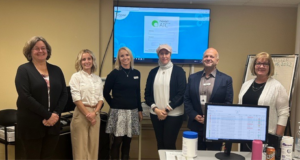Dramatic changes are coming fast as two factors, economic necessity and the digital revolution affect Ontario’s fragmented health and healthcare “system”. Four will predominate:
- People will demand that real, coordinated systems of care, in which the whole spectrum of health service providers (HSP)[i] are linked together, be established to facilitate patients’ digital communication with all care givers and make smooth their transitions among them
- Ontario Health Teams (OHT) and their HSPs will be connected to the people they serve by standardized, shareable, privacy-protecting, inter-connected health information systems,
- Virtual interactions will be substituted for many face-to-face contacts between patients and HSPs, and
- Algorithms and pattern recognition software (so-called AI) will increasingly reinforce decision-making in medical and other health professional practices[ii]
Such changes in Canadian healthcare, including in Ontario, have been long delayed by a combination of complacency and, until now, the availability of public resources sufficient to postpone change in the status quo. And yet public dissatisfaction with the developed world’s longest wait times[iii], accessing ‘primary care homes’ in the first place, and roadblocks to the inter-provider transfer of patients, especially from hospital to home and/or long-term care, continues unabated. And now it’s clear that in the ‘slow-growth’ economy healthcare’s disproportionate spending threatens the health of the population by its encroachment on support for the social determinants of health[iv]. The status quo offers no way to meet either the current or anticipated economic, healthcare or social needs of the people. The current illusory health/healthcare “system” has to be made real and achieve much greater productivity.
Driven especially by the fiscal imperative to slow the rate of cost increases, Ontario’s government has accepted the reality that genuinely integrated health and healthcare systems will only work when organized and operated by the HSPs who provide the services together with representatives of the people who use them. It has also recognized that those systems will vary somewhat in how to meet best the needs in the Province’s diverse urban, suburban, rural and remote districts and regions. Accordingly, it has called for the establishment of up to 30 to 50 Ontario Health Teams to pick up where the previous government’s 14 Local Health Integration Networks left off. OHTs are to be responsible for planning, organizing, and providing the full range of health and healthcare services needed to safeguard the health of the people of the community, district, or region they serve and to care for and restore to good health those who suffer illness, injury, or other disability. Just how and by what measures OHTs will be held accountable both to the populations they serve and to the government have yet to be determined.
For them to succeed, OHTs will have to see clear incentives in return for their taking on these responsibilities. One will be a high degree of independence, the ability to make their own decisions as appropriate for their particular communities, districts, or regions. Obviously, those decisions, largely operational in nature, will have to be consistent with Government policy, broadly defined, but none-the-less be free from central interference. Important as that freedom is, other material incentives will also be needed so the participants in OHTs, institutions, organizations, and individuals alike, find their participation in systemization rewarding. Change must be motivated.
Another imperative, equally important, is that OHTs must have the tools they need to discharge their mandates, principal among them being information and communication technologies (ICT). This includes the software systems needed to build that “standardized, shareable, privacy-protecting, inter-connected health information system”, to enable easy inter-provider transitions, and support virtual interactions both with patients and other HSPs in the team. Many components of such systems, including those developed by Novari Health, are in place now but far from universally and often reaching only some HSPs all of whom in every OHT must be linked together. Achieving ‘catch up’ in respect to deployment of these tools will be a challenge in the current and forecast financial environment but, nevertheless, it is one that must be met.
Finally, the whole purpose is to optimize the health of the population and meet its needs for health and healthcare services, achieving the best outcomes possible within the limits of the human, physical, and financial resources available. Progress toward those goals has to be measured so OHTs can adjust how they perform their functions in relation to the progress being made and also to discharge their accountability for the productive use of scarce resources. Appropriate, sensitive, and credible measures both of population health and of the outcomes of healthcare’s myriad processes/procedures, measured now mainly for billing purposes, remain yet to be developed. Doing so will also be a challenge for government, Ontario Health, OHTs and HSPs.
History has taught us that revolutions lead to big and fundamental changes. The digital revolution now upon us is no exception. We resist it at our peril. Designing change and embracing it is by far the better option.
Dr. Duncan G. Sinclair
May 14, 2019
About Dr. Duncan G. Sinclair, Fellow, School of Policy Studies
Professor emeritus of Physiology, Dr. Sinclair was Queen’s Dean of Arts and Science (1974-83), Director General of Program Operations of the Medical Research Council of Canada (1983-4), Queen’s Vice-Principal Institutional Relations (1984-6), Operations (1986-8), Health Sciences and Dean, Faculty of Medicine (1988-96). After retiring, he Chaired Ontario’s Health Services Restructuring Commission (1996-2000), served on the Boards of a number of health-related National, Provincial, and local Organizations, and continues, with Dr. David Walker, to teach a course in the School of Policy Studies on Canadian health policy.
References
[i] Systemization is also made imperative by the need for greater productivity and lower cost
[ii] See Topol, Eric. 2019. Deep Medicine. How Artificial Intelligence Can Make Healthcare Human Again. Basic Books, New York
[iii] Mirror, mirror, 2017. The Commonwealth Fund
[iv] Variably estimated to determine between 75 and 80 percent of the population’s health



